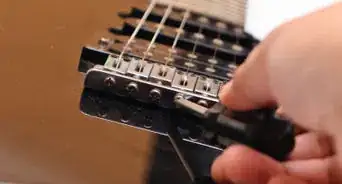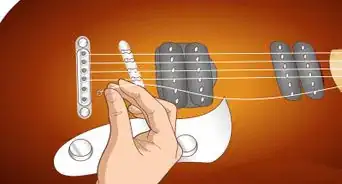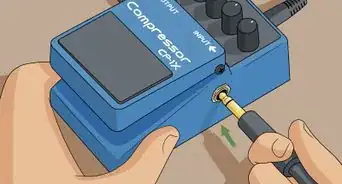This article was co-authored by Ron Bautista. Ron Bautista is a professional guitarist and guitar teacher at More Music in Santa Cruz, California and the Los Gatos School of Music in Los Gatos, California. He has played guitar for over 30 years and has taught music for over 15 years. He teaches Jazz, Rock, Fusion, Blues, Fingerpicking, and Bluegrass.
wikiHow marks an article as reader-approved once it receives enough positive feedback. In this case, 100% of readers who voted found the article helpful, earning it our reader-approved status.
This article has been viewed 216,891 times.
Is there anything better than plugging in? If you want to strap on an electric guitar and start wailing away like your personal guitar heroes, it can be hard to know where to start. Whether you want to get started playing guitar for the first time, or just want to jump into the world of electrics, learning about about the features and construction of electric guitars can help you make an informed choice. If you want to buy a used guitar, it's also a good idea to learn a bit about how to inspect each one to make sure you're getting a good deal and won't find any mystery problems later, when you get it home.
Steps
Finding the Right Guitar
-
1Learn the basic components of an electric guitar. Like an acoustic guitar, an electric is basically just strings that vibrate over wood, but with the addition of all kinds of confusing-looking selector switches and knobs. Learning to identify the basic components of electric guitars can help demystify the process and help you focus on the most important parts.[1]
- Pick-ups will be placed under the strings near when the guitar is plucked. There may be as few as one pick-up and as many as three or four, depending on the guitar. These are used to pick up the sound of the guitar, which vibrates an internal magnetic coil, producing an electric signal that travels through the amplifier.
- Volume knobs will be included, sometimes as many as three. These allow you to adjust the output volume of the guitar.
- Tone knobs are used to toggle between the high and low frequencies in the pick-up. There are usually different tone knobs for each pick-up in the guitar.
- Selector or cut-off switches are used to select between the individual pick-ups and activate them, or cut them off. On most guitars you can use some combination of different pick-ups.
- The output jack is usually on the back-end of the guitar, or the bottom lip, where the guitar is plugged in to the amplifier via quarter-inch cable.
-
2Decide what kind of body style you want. To the untrained eye, all electric guitars might look basically the same, but body styles can be broken into several basic categories, each with its own subtleties of sound and playing style. Some body styles work better for certain genres, though there's no rule that says so. Lots of it has to do with your personal playing style and the music you want to make.[2]
- Solid body guitars are sturdy and weighty, made of a single piece of wood. Because there's no resonance chamber, solid-body guitars must be played through amplifiers. The variety of pick-ups and the electronics of a solid-body guitar are very important. These are the go-to guitars for rock 'n roll, punk, and metal music. Famous solid-body guitar styles include the Fender Stratocaster and the Gibson Les Paul.
- Hollow body electric guitars are, as the name suggests, hollow on the inside of the body. While there's no sound hole as will be found on an acoustic guitar, hollow-body electric guitars will often use a different variety of pick-up than a solid-body guitar. These are often used for playing jazz, featuring a warm and deep mid-range, and work best with mellow, low-volume amplifiers.
- Semi-hollow body electric guitars are hybrid models that feature a cut-out design and a small hollow portion of the body. These guitars have a bright and chime-like tone that's perfect for country music, folk-rock, and for lead-guitar work. The Rickenbacker and the Gibson ES are famous semi-hollow guitar models.
- Electric-acoustic guitars look basically like acoustic guitars, but feature pick-ups that allow them to be played like electric guitars. While these typically will have fewer features than other forms of electric guitars, electric-acoustics offer the versatility of playing them without the use of amplification.
Advertisement -
3Learn a bit about tone woods. Primarily, the sound of a given electric guitar will come from the pick-up, though the pick-ups of a guitar can be changed out, customized, and upgraded. For a reason, it's important to give some consideration to the wood that the guitar is made from, but beginners will likely not notice a huge difference in sustain, so try not to be led down a garden-path by a salesman telling you that you have to upgrade to koa wood. Still, it's good to learn a bit about the different types of woods used to demystify the process.[3]
- Most bodies are made of maple, mahogany, or poplar. Maple is known for its long sustain and bright character, while mahogany is known for its warmth. Poplar is great for bright and crispy high-register tone.
-
4Look to your guitar heroes for inspiration. Let's face it, the number one reason most people end up picking the guitar they pick is because it looks cooler than all the others. This is a perfectly legitimate reason to pick a guitar. Almost every guitar player who ever picked up an axe did so because they saw some other guitar player who looked awesome standing on stage.
- Famous Gibson Les Paul pickers include Jimmy Page, Zakk Wilde, Slash, Randy Rhoads, and Bob Marley.
- Famous Fender Stratocaster players include Jimi Hendrix, Eric Clapton, Buddy Guy, and Stevie Ray Vaughn.
- Other iconic guitar models include the Gibson SG, played by Angus Young, the Fender Telecaster, played by Bruce Springsteen, the Gibson Flying V, played by Kirk Hammett, and the Fender Jazz Master, played by Kevin Shields, Elvis Costello, Thurston Moore, and J Mascis.
-
5Don’t be afraid of deals. Gearheads often fall into the same trap, thinking that super-expensive and obscure gear is also better than cheaper industry standard stuff. Sometimes, this is the case, but if you’re looking for a guitar to learn on, don't judge by the price. There are expensive guitars that have the resonance of a brick, and there are cheap guitars that really sing. Old Fenders that sell for thousands of dollars today started out life as inexpensive solid body guitars.
- By the same token, if you're going to invest in a guitar to learn on, you need to get something that's worth playing. Toy guitars sold at places like Walmart aren't even worth the low price tags offered. It's better to go for a used guitar or a cheaper model of the guitar you want. Fender offers the "Squire" series, using somewhat cheaper materials, but the same designs as their other more expensive guitars. You can get a Squire Strat for around $300, compared with the $1400 it might cost for an American Stratocaster, if you're lucky.
- Explore used guitars and do your research to find deals. Some players will only play guitars that have been broken in a bit and worked over by other players. Neil Young is known for only playing old guitars, for example, and never plays new ones.
Getting the Rest of the Gear
-
1Get an amplifier. An electric guitar isn't much good without an amp, which can be one of the hidden costs of the electric guitar purchase. Playing an expensive Gibson through a crappy practice amp doesn't make a whole lot of sense. Save enough room in your budget for a good quality amplifier to make that guitar you gave so much thought to sound great, as well.
- Consider your needs and buy an amp with enough output for your purposes. Also check out the customizable features on each amp, including reverb, tremolo, and other effects which can be fun to play around with.
- Solid-state amplifiers are the most inexpensive amps, based on semiconductor circuit models. For the beginner, these are usually fine purchases. More experienced guitar players usually favor more up-scale tube amplifiers, which feature vacuum tubes which need to be warmed up before putting a current through them.
- Combo amps feature an amp "head" placed on top of a larger speaker. The Marshall stack is an iconic combo amp. These are usually used for performance and for putting out large amounts of sound. Unless you're planning on gigging in the near future, a combo amp is probably overkill.
-
2Buy a quarter-inch cable. It'd be a shame to get home from the guitar place with a guitar and an amp and nothing to connect the two. Guitar cables are usually between five and ten bucks a pop, featuring quarter-inch jacks on both sides. Make sure you're getting the right kind of cable at the guitar place. Any good store should make sure you walk out with everything you need, but it's good to be sure.
-
3Buy anything else you'll need to play. Picks, a guitar strap, and an electronic tuner are all essential electric guitar components. It's difficult to tune an electric guitar to anything, and most electronic tuners will allow you to plug straight into the unit with your quarter-inch cable, making it super-easy to adjust your sound and make sure your instrument is in tune. These can be as cheap as 10 dollars or so.
-
4Wait on pedals at first. The world of guitar pedals is vast and semi-complicate. Though there's probably nothing more fun than stomping on a distortion pedal and letting 'er rip, or channeling together a bunch of Echoplex pedals and vibrato units and making outer space symphonies without playing a note, it's probably an unnecessary investment when you're first getting started. Learn the basics and see what your amp is made of before you start messing around with guitar pedals.
Inspecting a Guitar
-
1Check the intonation of the guitar. When you pick up the guitar, play up the fretboard a bit and hold out individual notes.[4] When you pluck a string, you should be able to get a vibration in the wood that you can hear all over the guitar. It should last a few seconds.
- The pickups can be changed for very little money, but the wood makes the guitar. Hold a note and listen to the sound decay–does the guitar have a long, warm sustain? Or is it short and metallic? This will depend on the wood and the installation of the neck, which affects the guitar’s sound in a big way.[5]
- The guitar should also be in tune in both the 5th and 12th frets. Play up the frets and make sure that a barre chord in first position is in tune, and a bar chord up the scale is in tune. If not, the neck needs adjusted.
-
2Check the scale length up the neck. The scale length refers to the length of the string as it actually vibrates, so it’s measured by the distance between the nut and the saddle of the bridge. The scale can be longer or shorter, depending on this length. What this means for you is comfort. You want to make sure the frets are a comfortable and playable distance apart. Most modern electric guitars are one of two basic scales:
- Gibson scale is 24.75 in. This gives the Les Paul its round tone and its hefty bottom end. Anyone who's ever picked up a Les Paul knows the gravity of it. This is partially the scale.
- Fender scale at 25.5 in. The Fender scale offers a clear and bright playability, great for leads and those Hendrix-style outer space explorations.
- A 25″ scale is sometimes used by other manufacturers like PRS guitars, offering its own distinctive tone.
-
3Check the action of the guitar. Action refers to the height of the strings off the fret board. A “high” action means the strings are far off the board, making it require more finger pressure to play each note.[6] “Low” action means the strings are just off the fret board, easier to press. When you play the guitar, pay attention to how far off the strings are and how difficult it is to play the individual notes.
- Most used guitars will need to be set up, so a certain amount of string buzz can be fixed. If you’re buying a used guitar, though, you need to check for buzzy frets and consider getting the neck adjusted to properly raise the strings off the fretboard to the height you like.
-
4Make sure the neck feels comfortable in your hands. You have a number of nut widths, which set the distance from the E string to high E string. The other features the shape of the back of the neck.[7]
- If the guitar doesn't sound good or feel good in your hands, you won't be as motivated to play it.[8]
-
5Look at the kinds of pickups used. Primarily, the sound of the guitar coming out of the amp will be made possible by the pickups. When you're first starting out, you probably won't notice a huge difference, or might not care much about the pickups, but it's less complicated than it seems. Learning to differentiate between the two most basic and most common styles of pickup will help you make an informed choice. Some guitars will come with both styles, while others will have one or the other.[9]
- Single-coil pickups have a glassy tone, great for blues and rock and roll leads. These will be oval-shaped, and have little metal spots, one per string, under the guitars. Stratocasters come custom with single-coil pickups.
- Humbucker pickups were designed as improvement to the single coil pickups, giving you more of a growl when cranked up loud. They're rectangular shaped and made of metal. If you plan on strumming and getting some distortion in your sound, you'll likely want a guitar with at least a humbucker pickup.
- Some guitars will have different kinds of pickups, for example, P90 pickups were the most popular among guitarist, the sound that they have is that mean growl from humbuckers but a warm bass tone along with it. With distortion, these pickups had made a mark on guitar history.
-
6Examine the bridge. The bridge of an electric guitar will feature a number of different designs, some more complicated than others.[10] Some “floating” bridges feature tremolo bars, also known as “whammy bars,” which allow you to bend the bridge and “dive” the sound accordingly. These can be customized but are standard on some guitars.
- It's good for some players to notice where the bridge lays in relation to where you hand wants to naturally rest on the guitar. Some guitars look great but have somewhat sharp or awkward bridge-placement, which can make it a challenge to play comfortably. Likewise, some bridges have irritating string-guides, which can make restringing a challenge. It's a good idea to consider these topics when making a selection.
Community Q&A
-
QuestionWhat is better to buy - an expensive good guitar or an expensive amplifier?
 Community AnswerNeither if it is your first. Go for the middle ground in both aspects.
Community AnswerNeither if it is your first. Go for the middle ground in both aspects. -
QuestionA friend of mine bought a Fender Stratocaster some years ago, only to find out that only the neck of the guitar was Fender, the body wasn't. How can I tell if the whole guitar it is a Fender Stratocaster?
 Community AnswerYour best bet is to check cavities, or remove the pick ups or scratch plate to look for stamps. That way you can really know where the body comes from.
Community AnswerYour best bet is to check cavities, or remove the pick ups or scratch plate to look for stamps. That way you can really know where the body comes from. -
QuestionWhere do I learn how to play?
 Community AnswerIf you have a guitar, YouTube is an endless resource for just about every kind of music. There are a ton of excellent teachers on there. There's nothing wrong with getting started with video tutorials, then looking for a local teacher.
Community AnswerIf you have a guitar, YouTube is an endless resource for just about every kind of music. There are a ton of excellent teachers on there. There's nothing wrong with getting started with video tutorials, then looking for a local teacher.
Warnings
- Many inexpensive guitars you will find at large stores like WalMart or Toys R Us often have problems with frets and intonation so avoid those if you're looking to buy an actual guitar. Also, while 'starter packs' can be inexpensive, but seem like good products, don't be fooled. The amps often give you limited control over your sound, and aren't worth the money.⧼thumbs_response⧽
References
- ↑ https://www.sweetwater.com/insync/electric-guitar-buying-guide/
- ↑ https://thehub.musiciansfriend.com/guitar-buying-guides/buying-guide-electric-guitars#body
- ↑ https://www.gear4music.com/news/article/Which-Guitar-Should-I-Buy-Beginners-Electric-Guitar-Guide/7KK/2018-08-22
- ↑ Ron Bautista. Professional Guitarist & Guitar Instructor. Expert Interview. 5 November 2019.
- ↑ http://thehub.musiciansfriend.com/guitar-buying-guides/buying-guide-electric-guitars
- ↑ Ron Bautista. Professional Guitarist & Guitar Instructor. Expert Interview. 5 November 2019.
- ↑ https://www.gear4music.com/news/article/Which-Guitar-Should-I-Buy-Beginners-Electric-Guitar-Guide/7KK/2018-08-22
- ↑ Ron Bautista. Professional Guitarist & Guitar Instructor. Expert Interview. 5 November 2019.
- ↑ https://www.editorskeys.com/blogs/news/how-to-choose-the-best-guitar-factors-to-consider-according-to-science
About This Article
To choose an electric guitar, start by deciding what kind of body style you want. For example, a hollow body guitar is often used for playing jazz due to its warmer sounds, while a solid body is a go-to for rock and punk music. Next, look at what kinds of guitars your music heroes use, and ask yourself if you like their sound and if that’s the style of music you want to play. When you start shopping, don’t be afraid to look at used guitars and research to find good deals. To learn how to inspect a guitar before you buy it, keep reading!
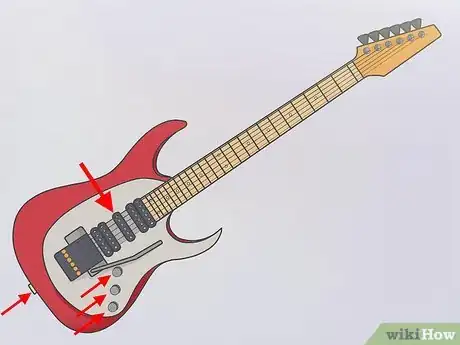
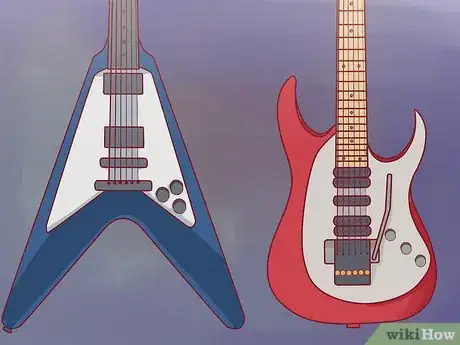










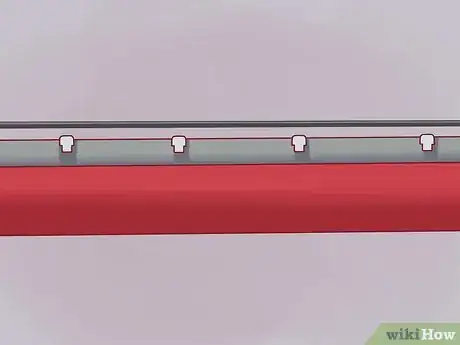
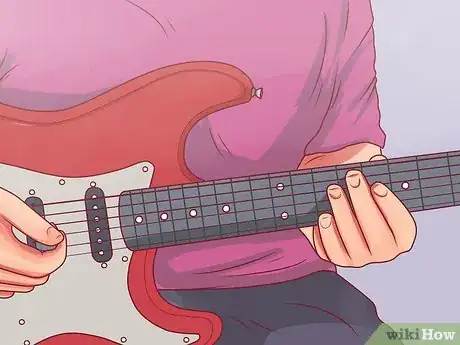
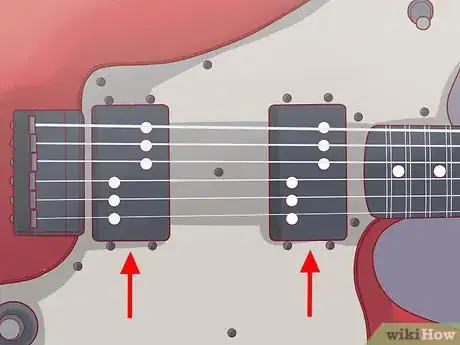



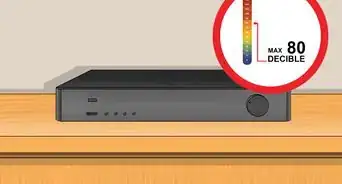

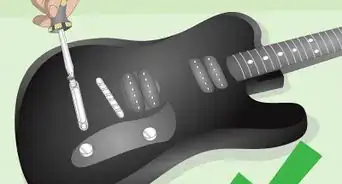
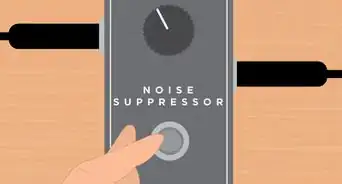

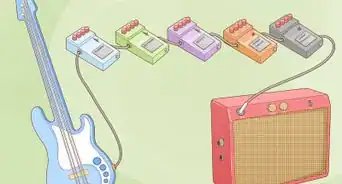
-Step-19-Version-2.webp)
